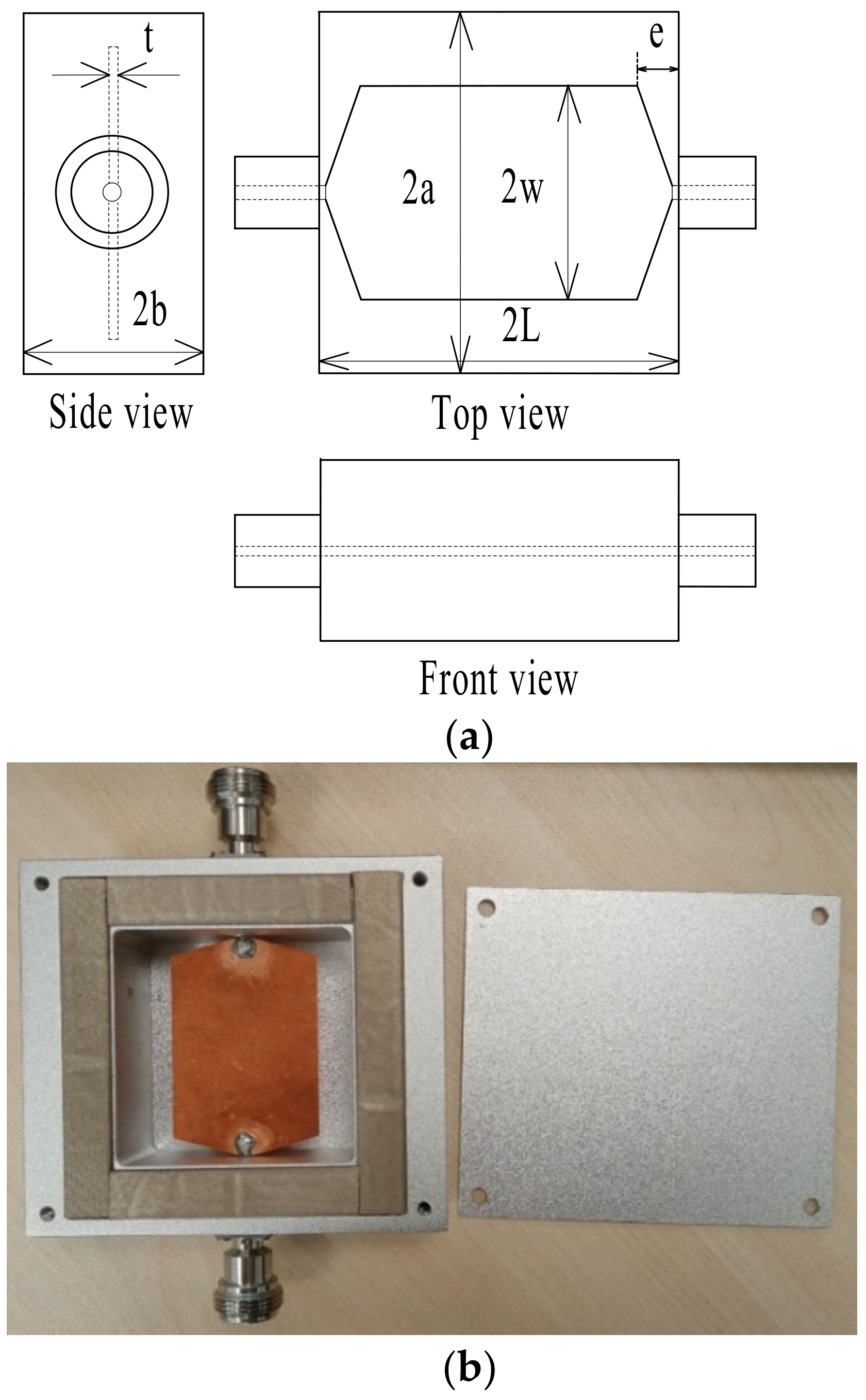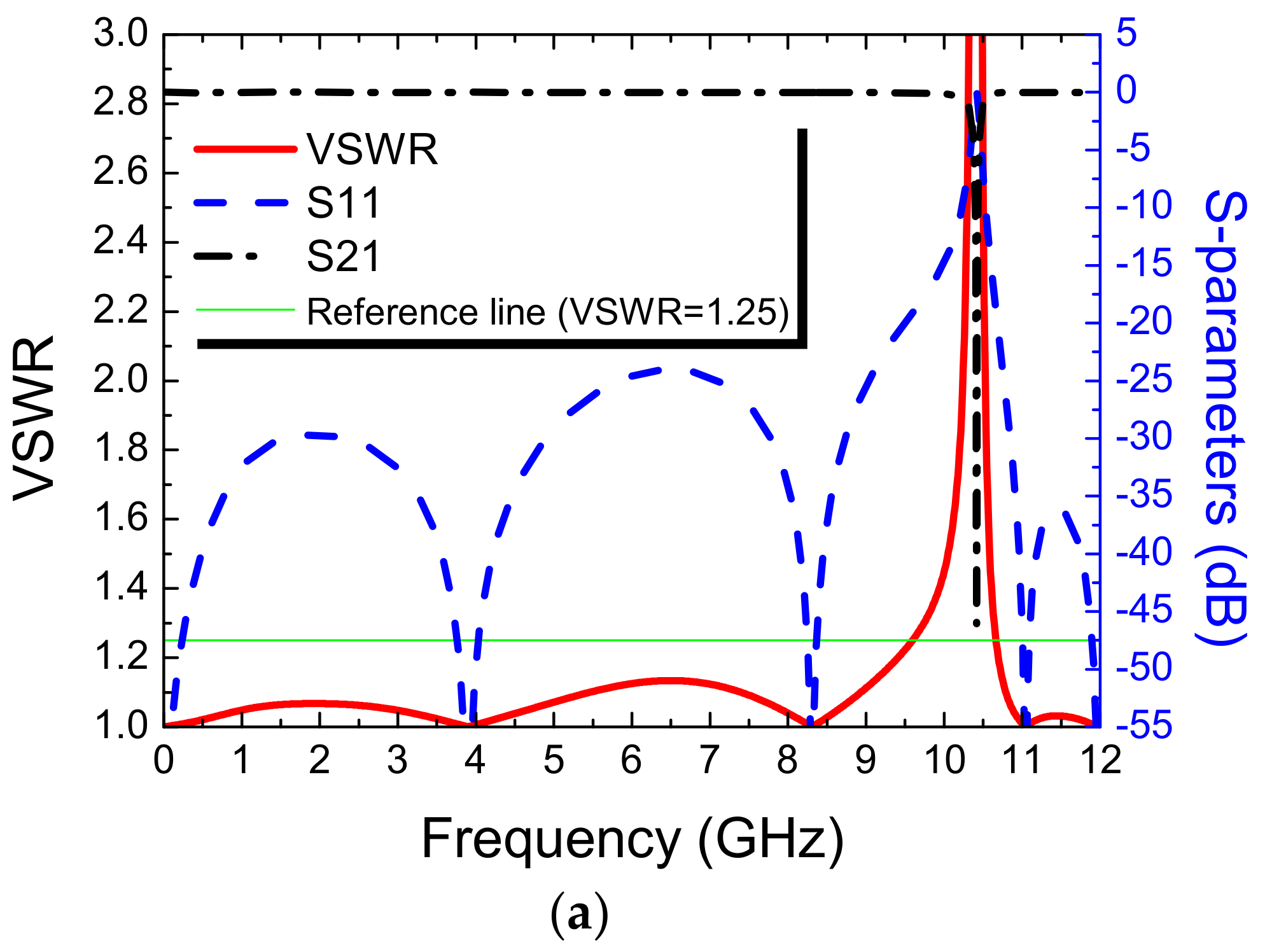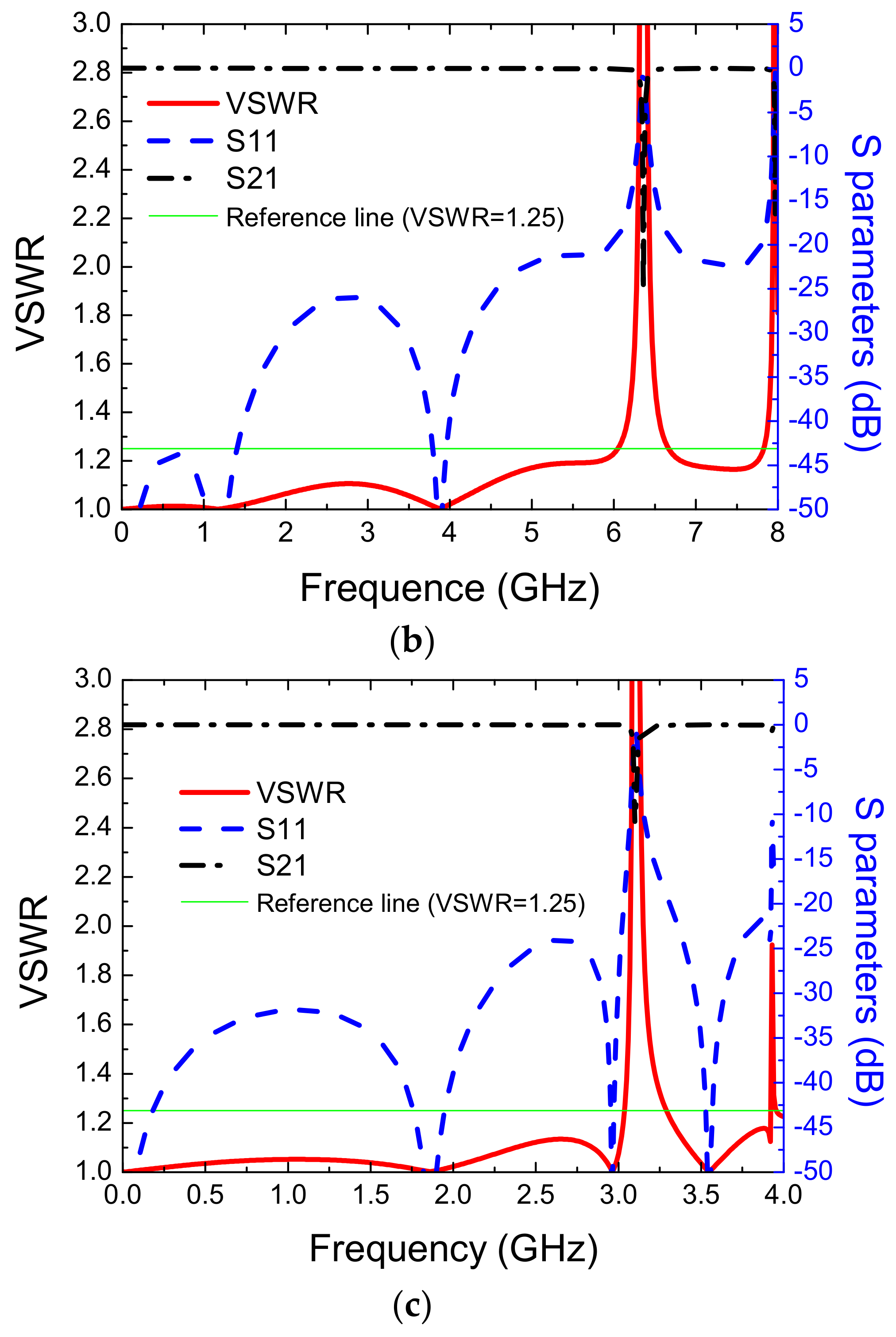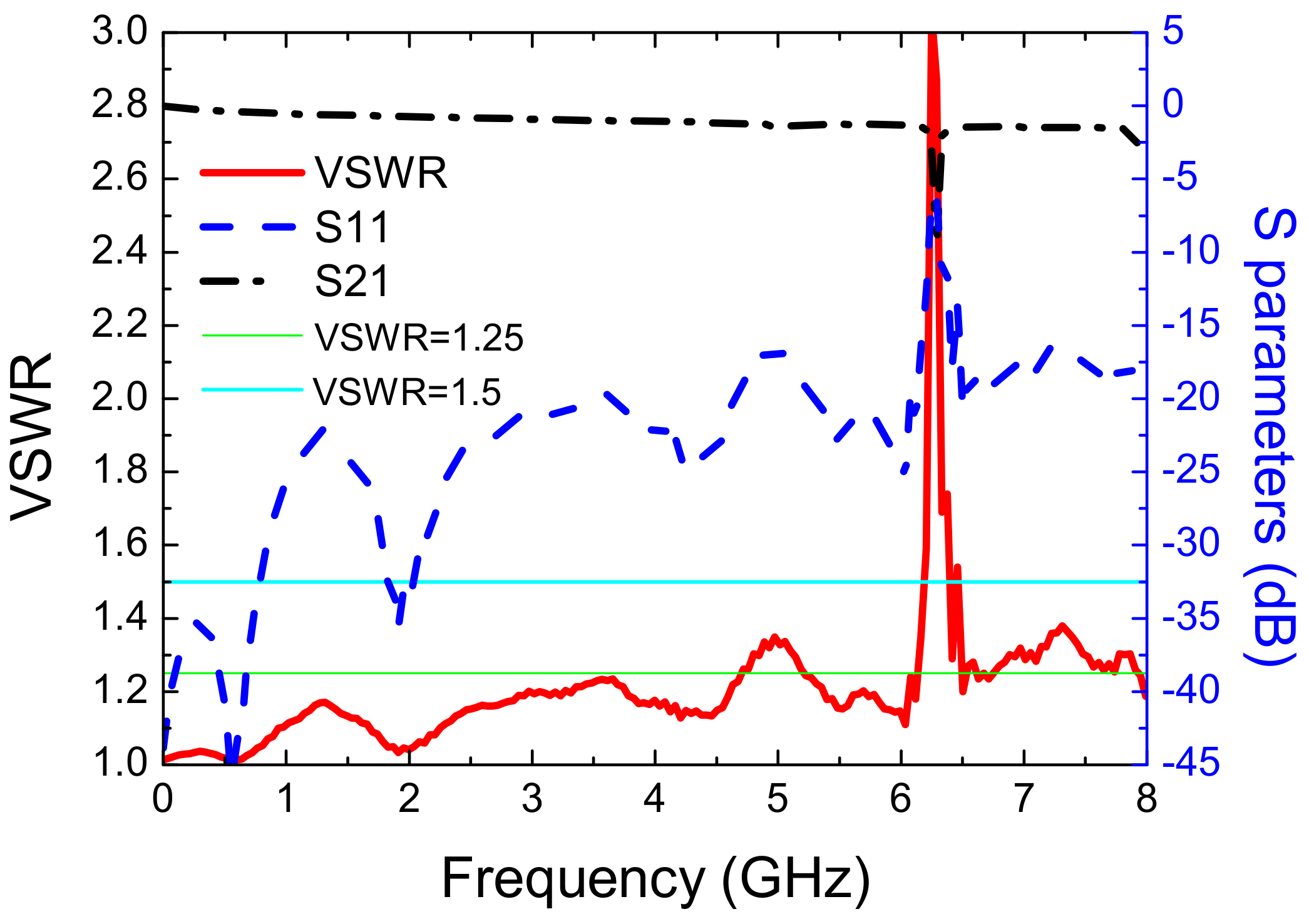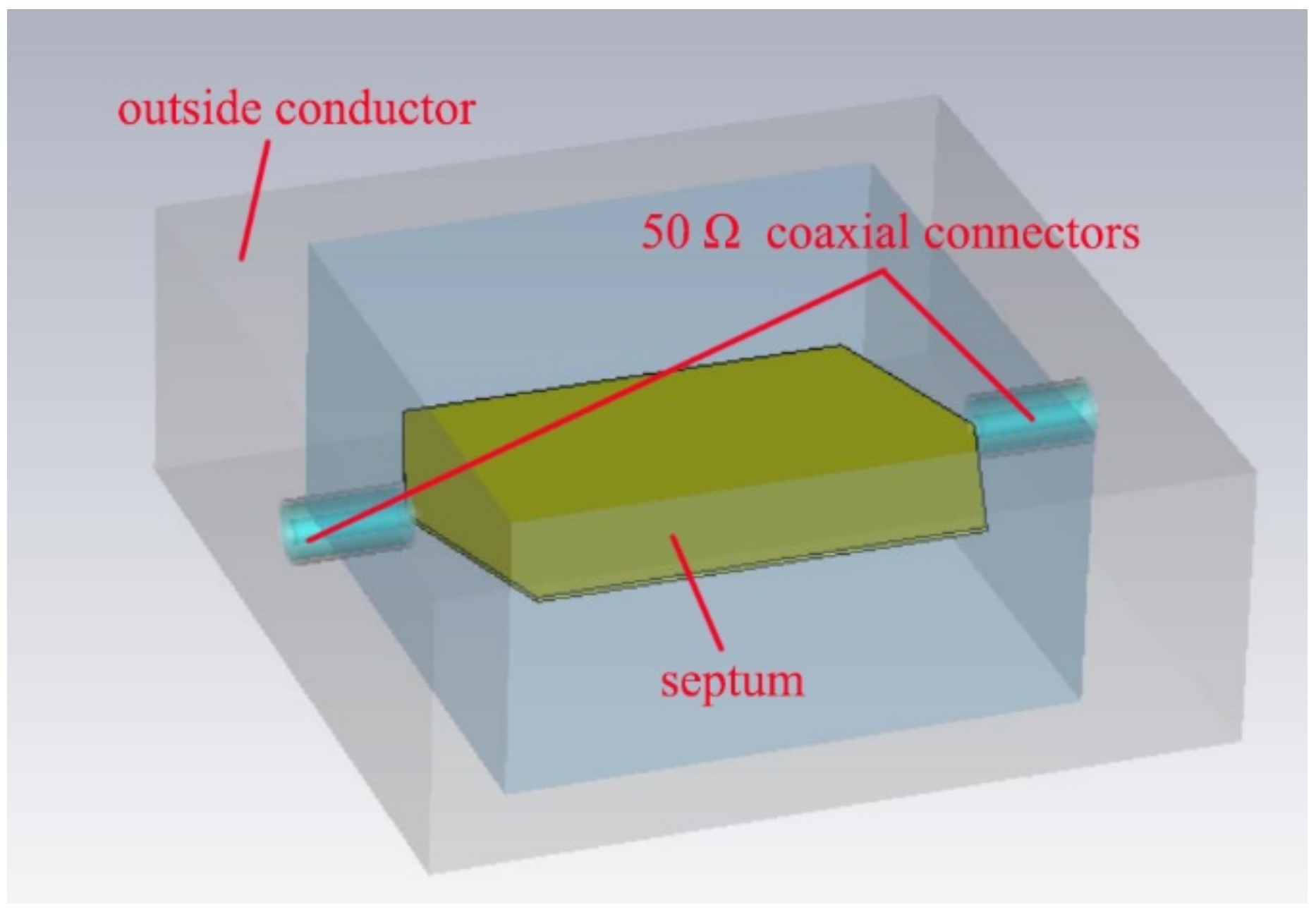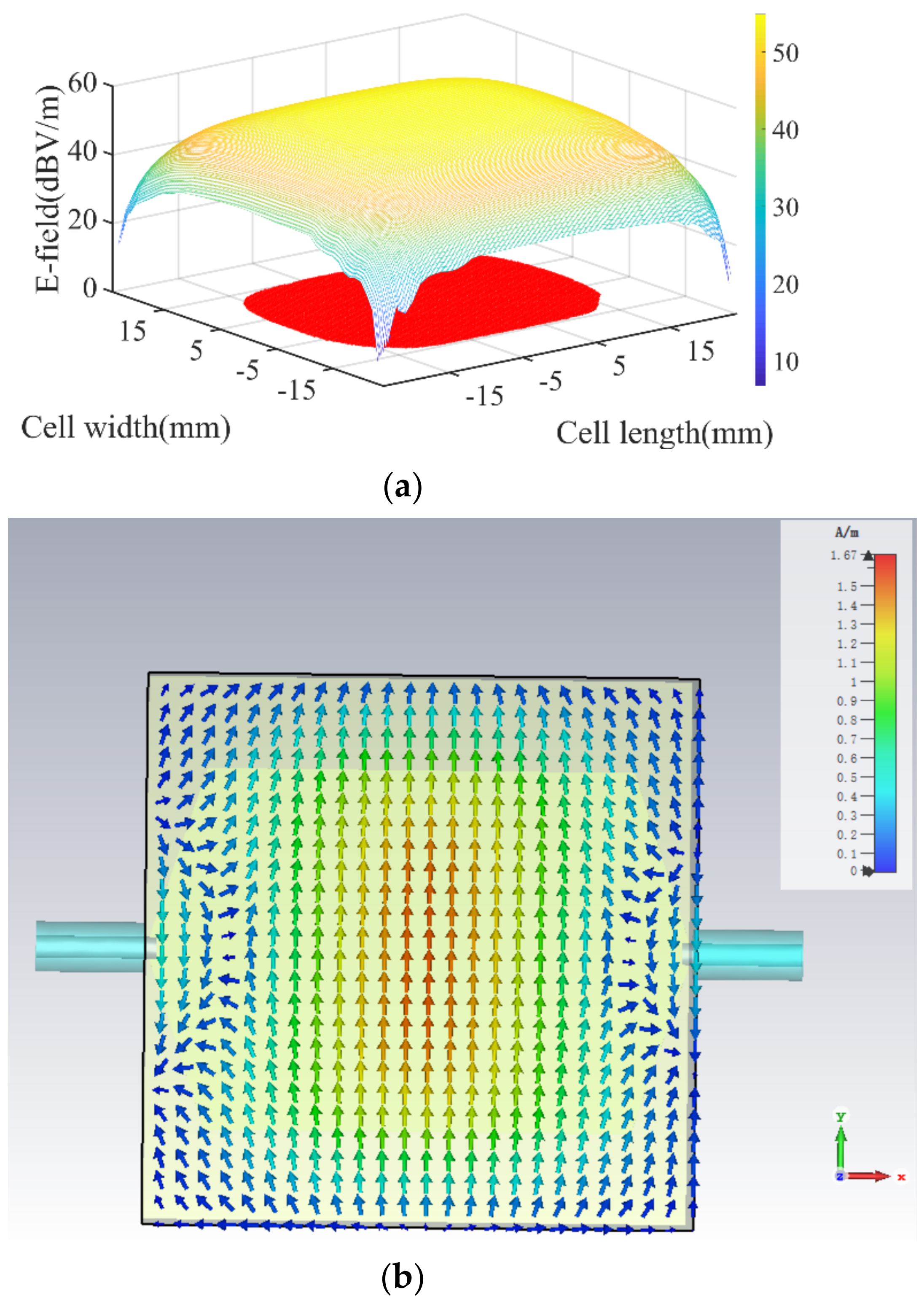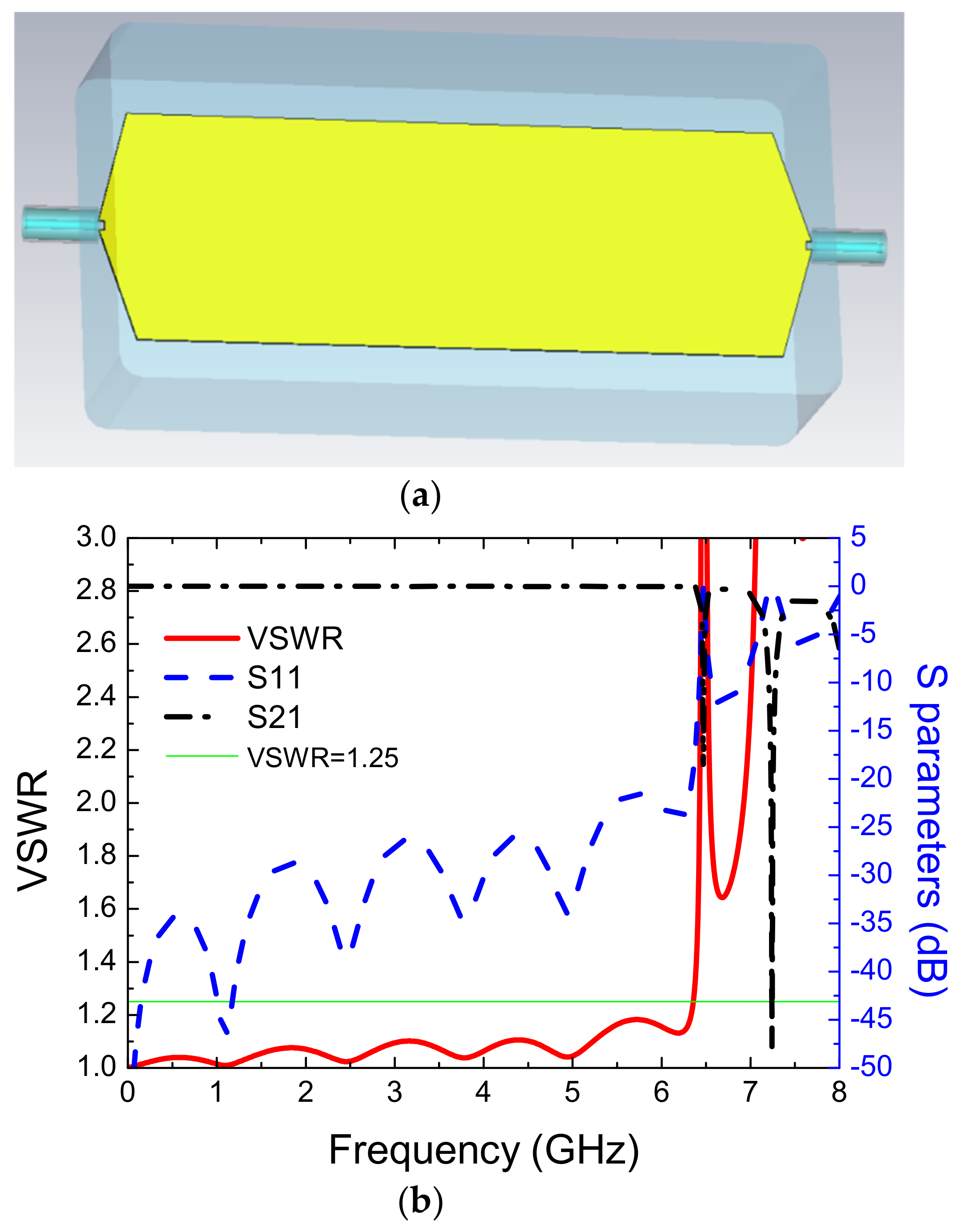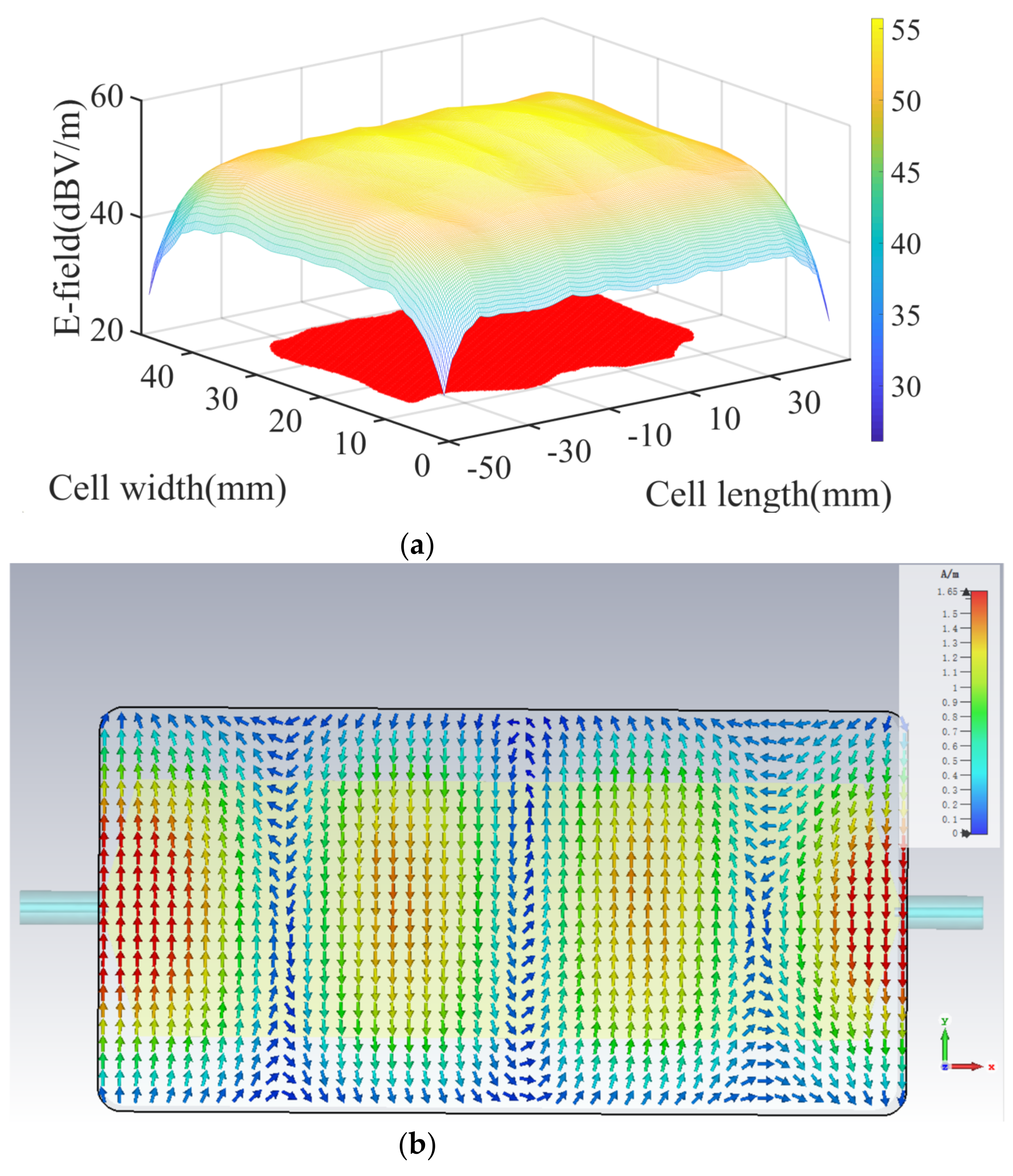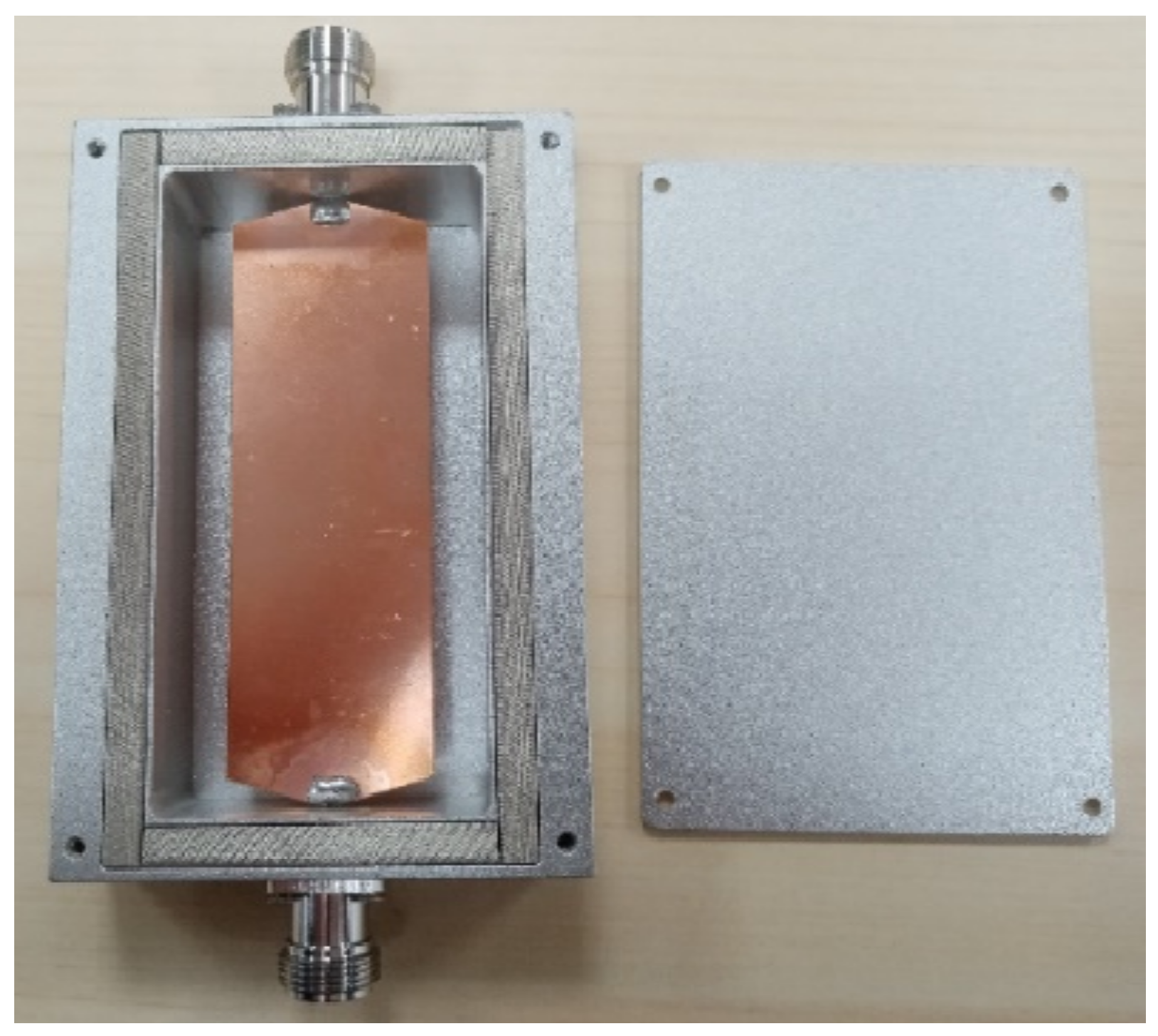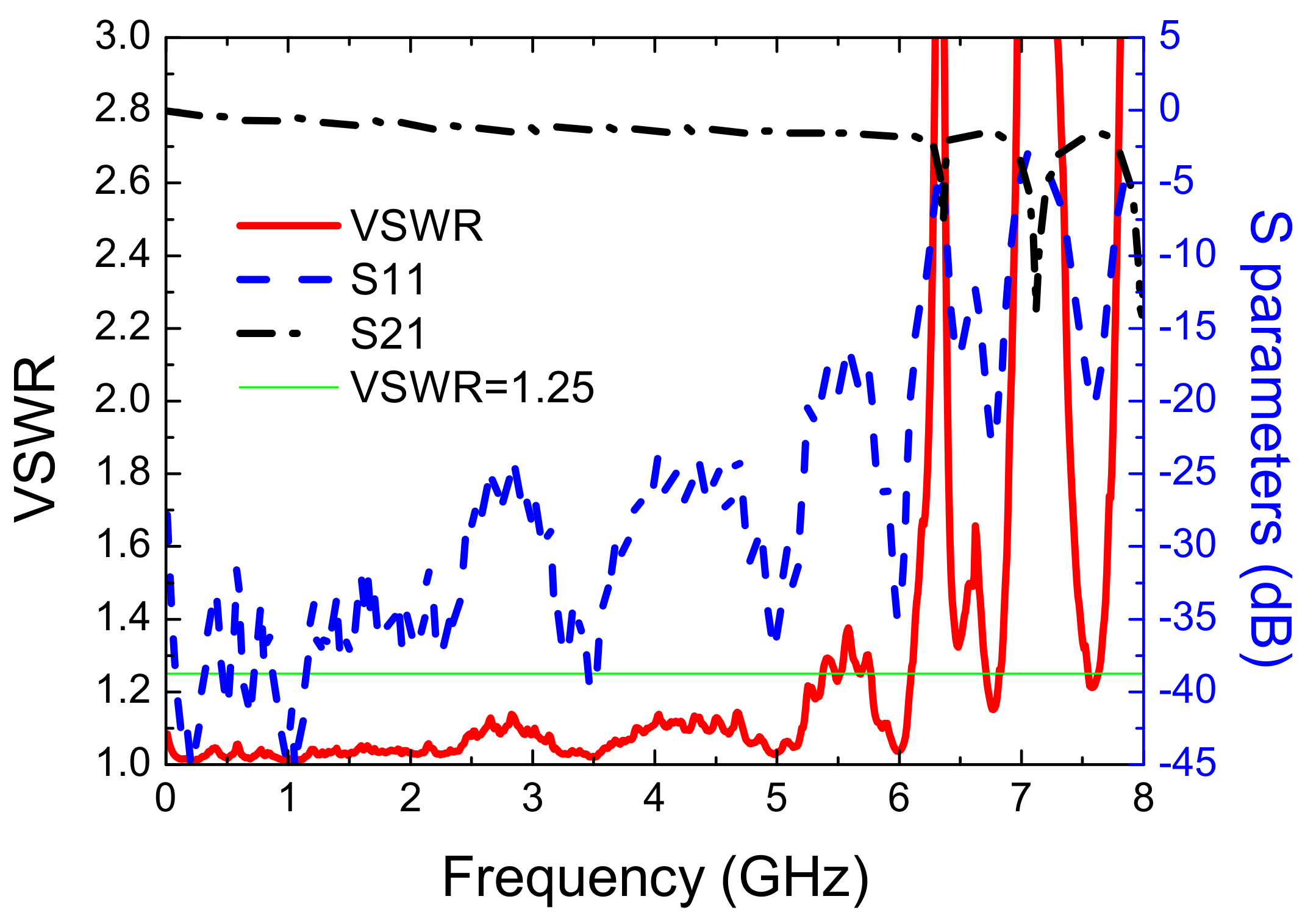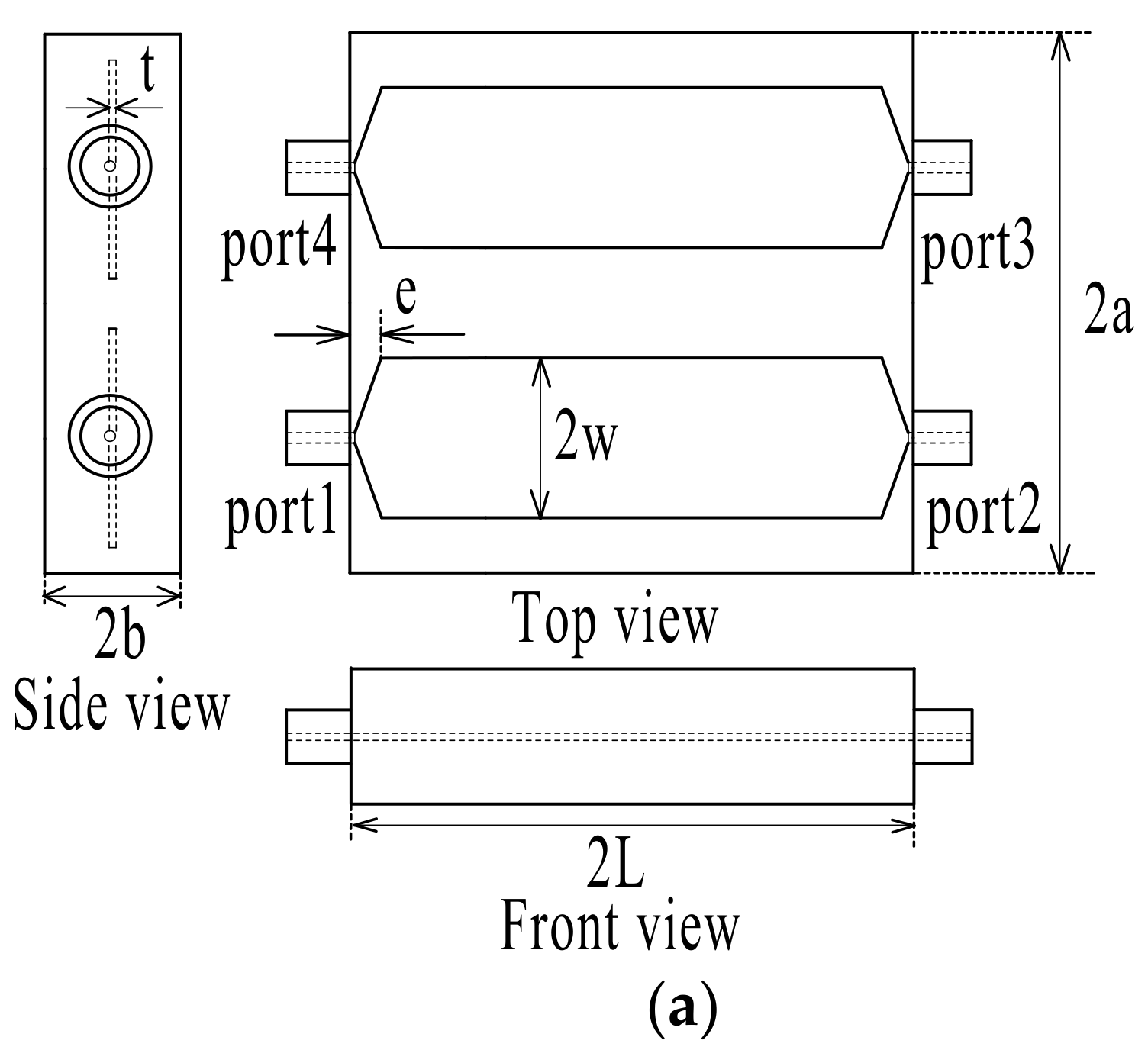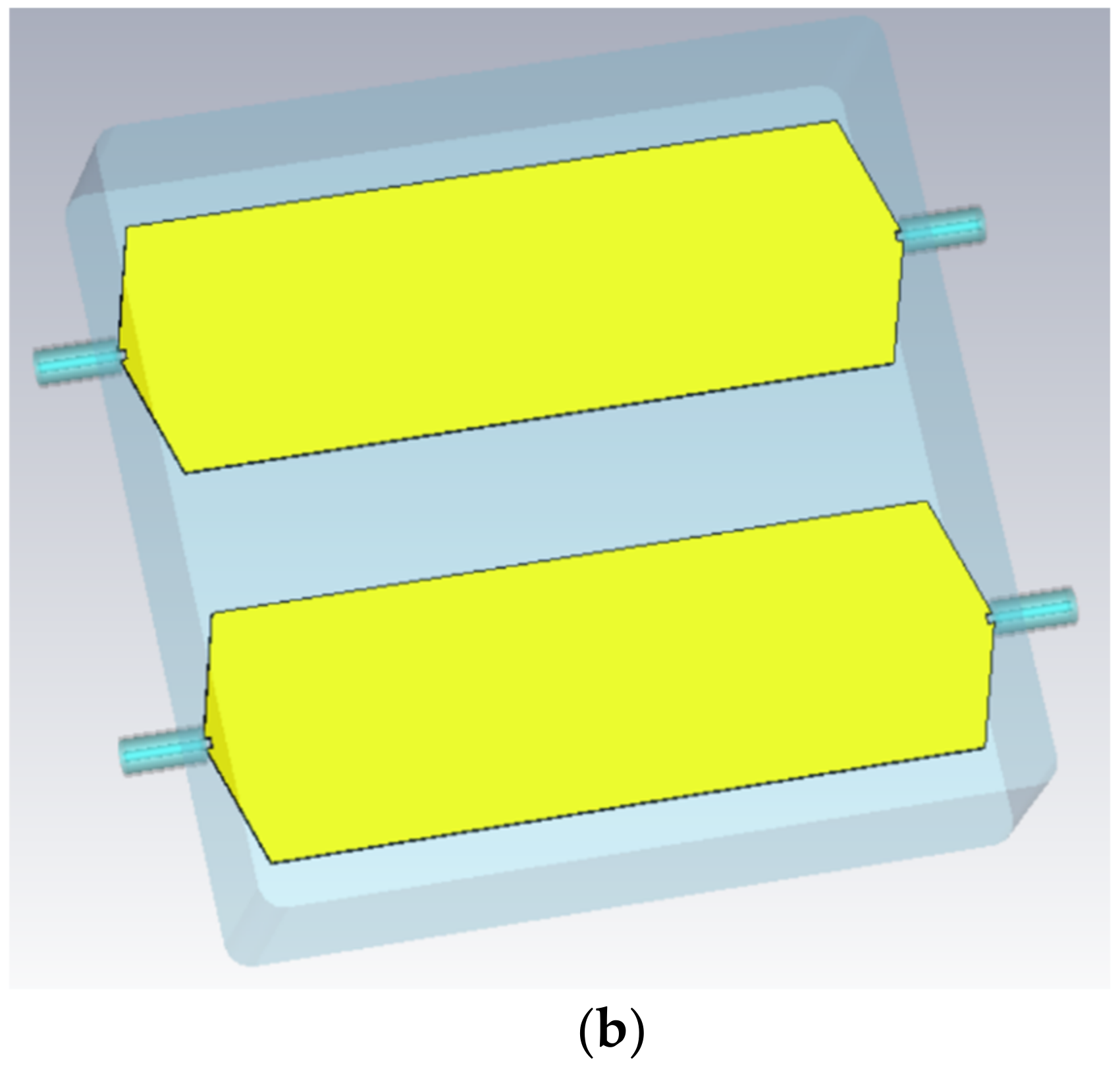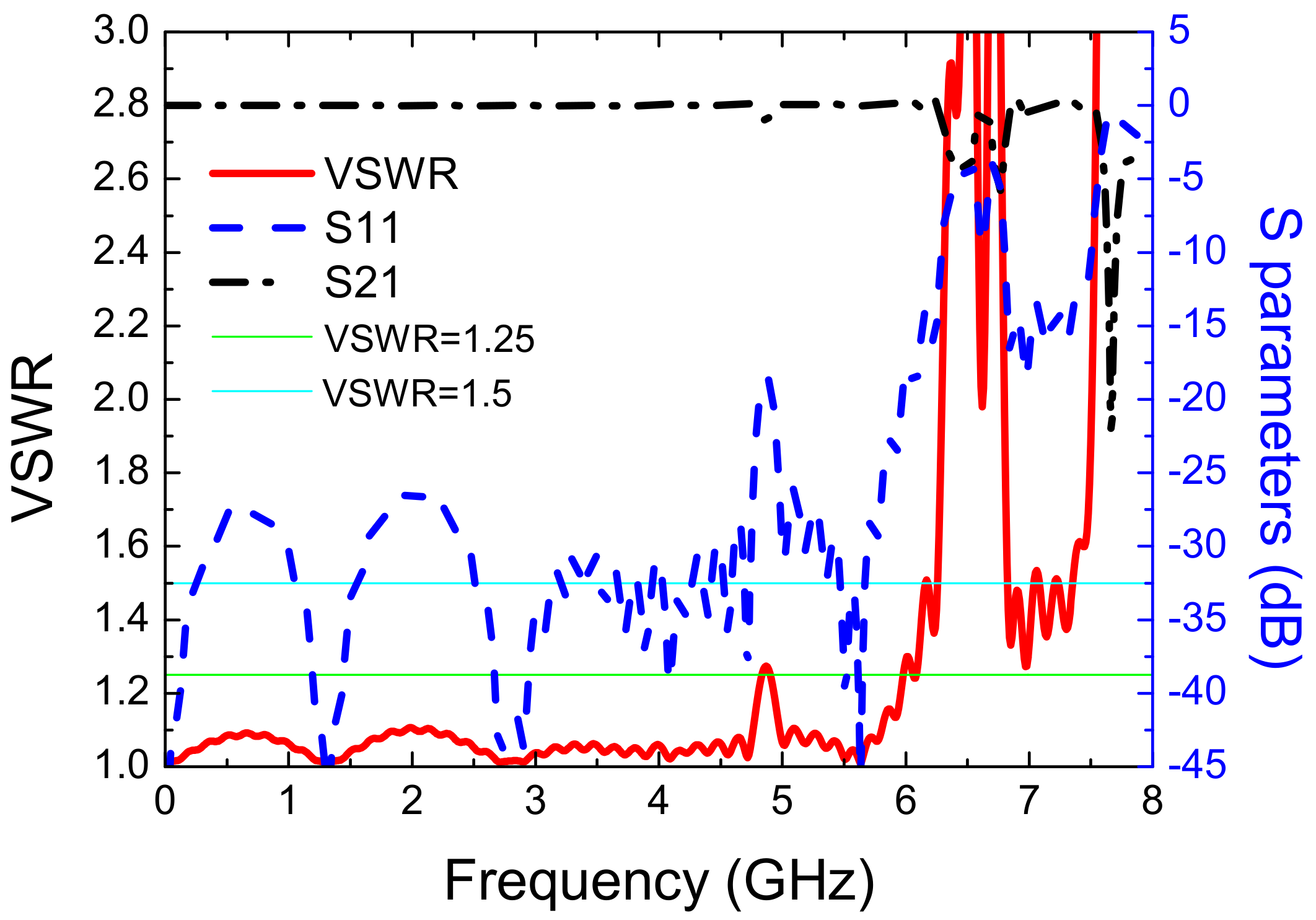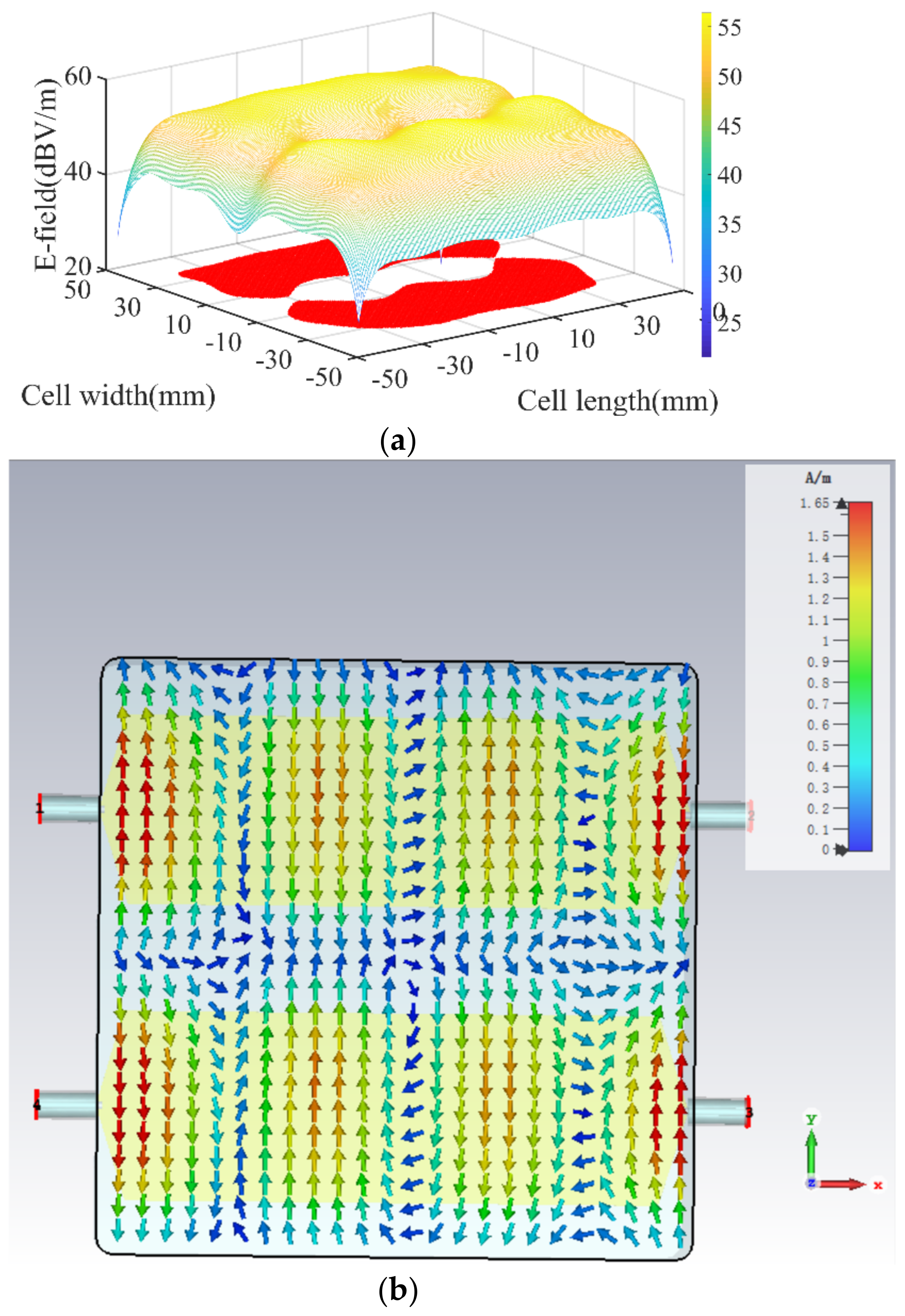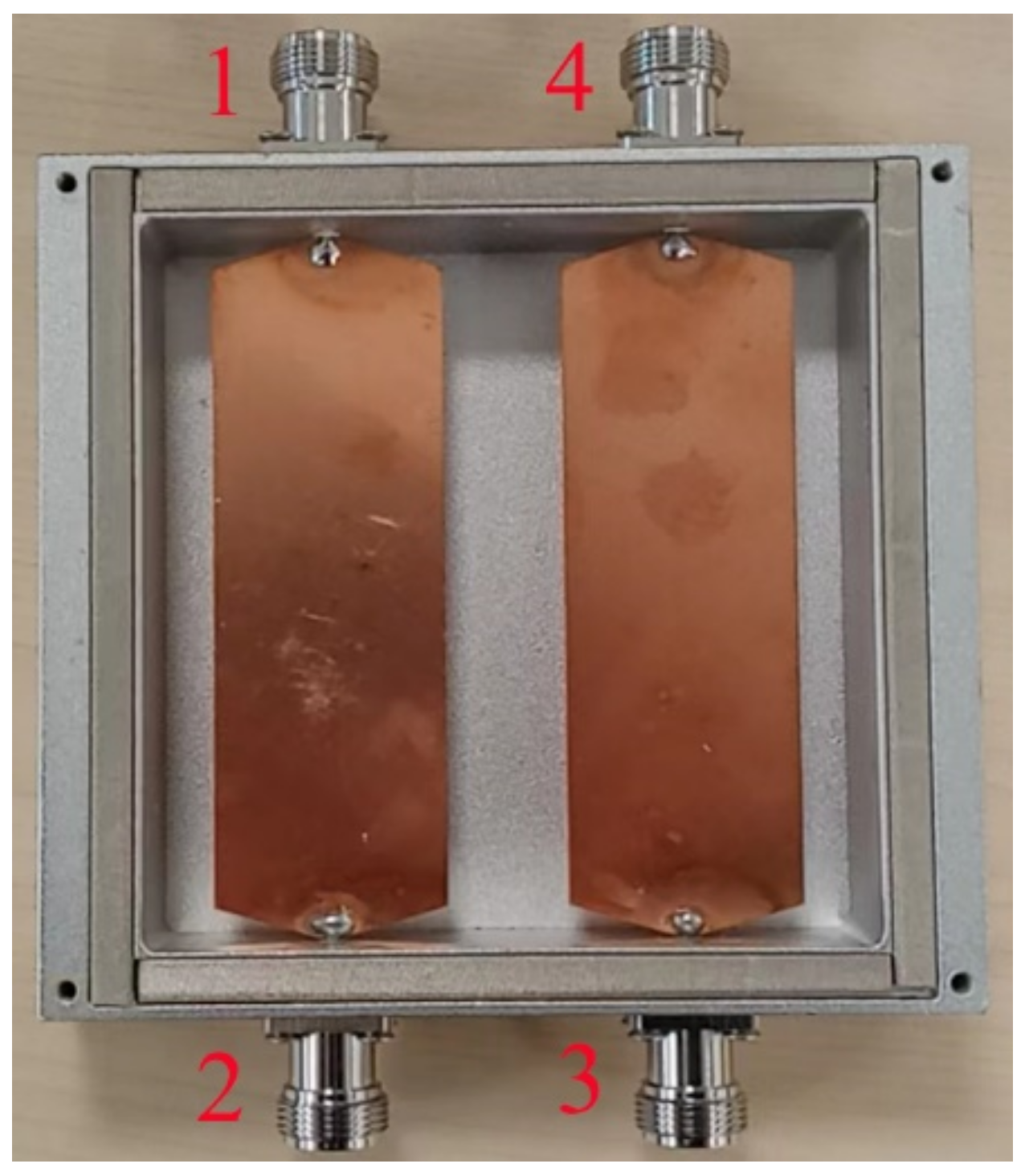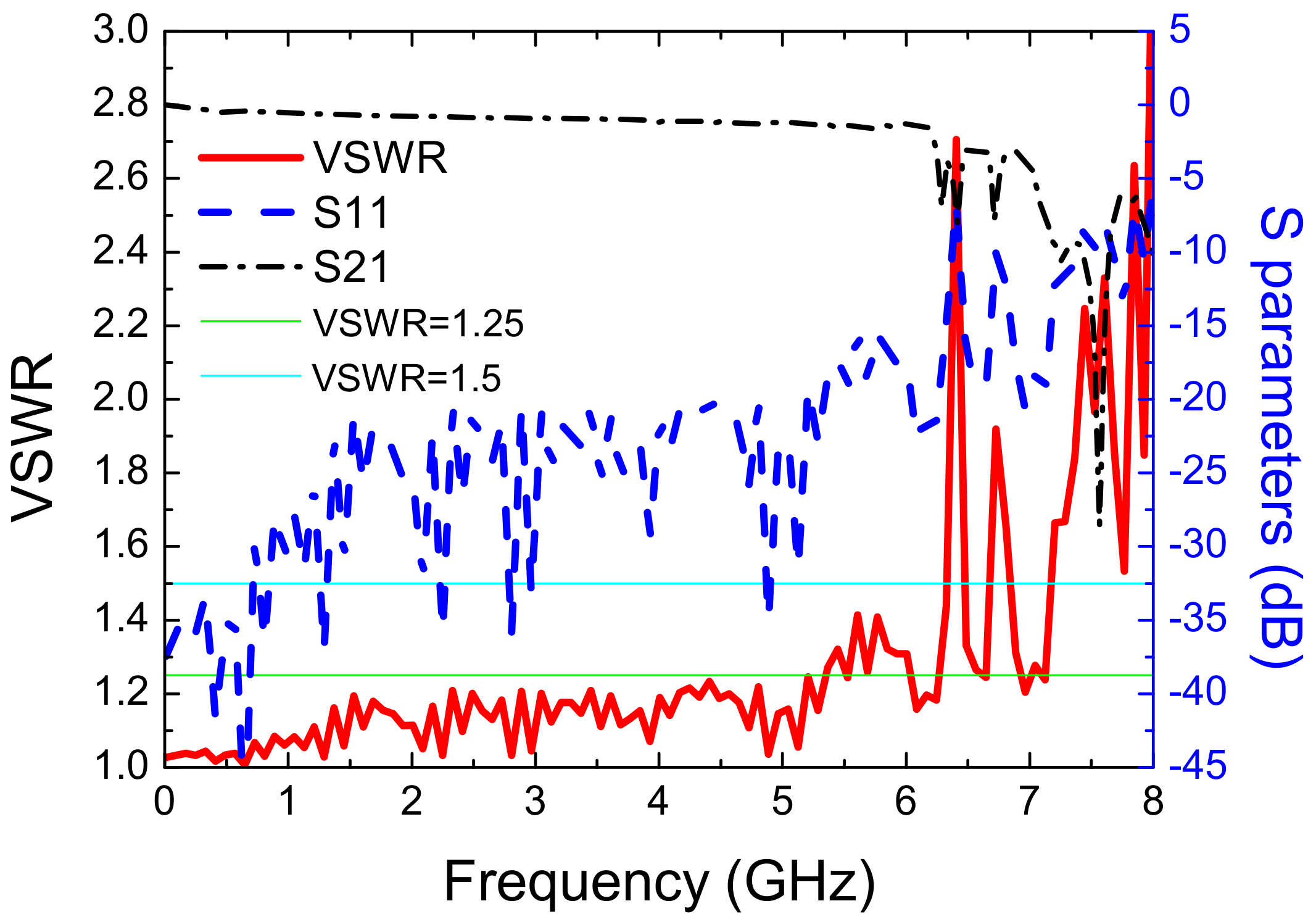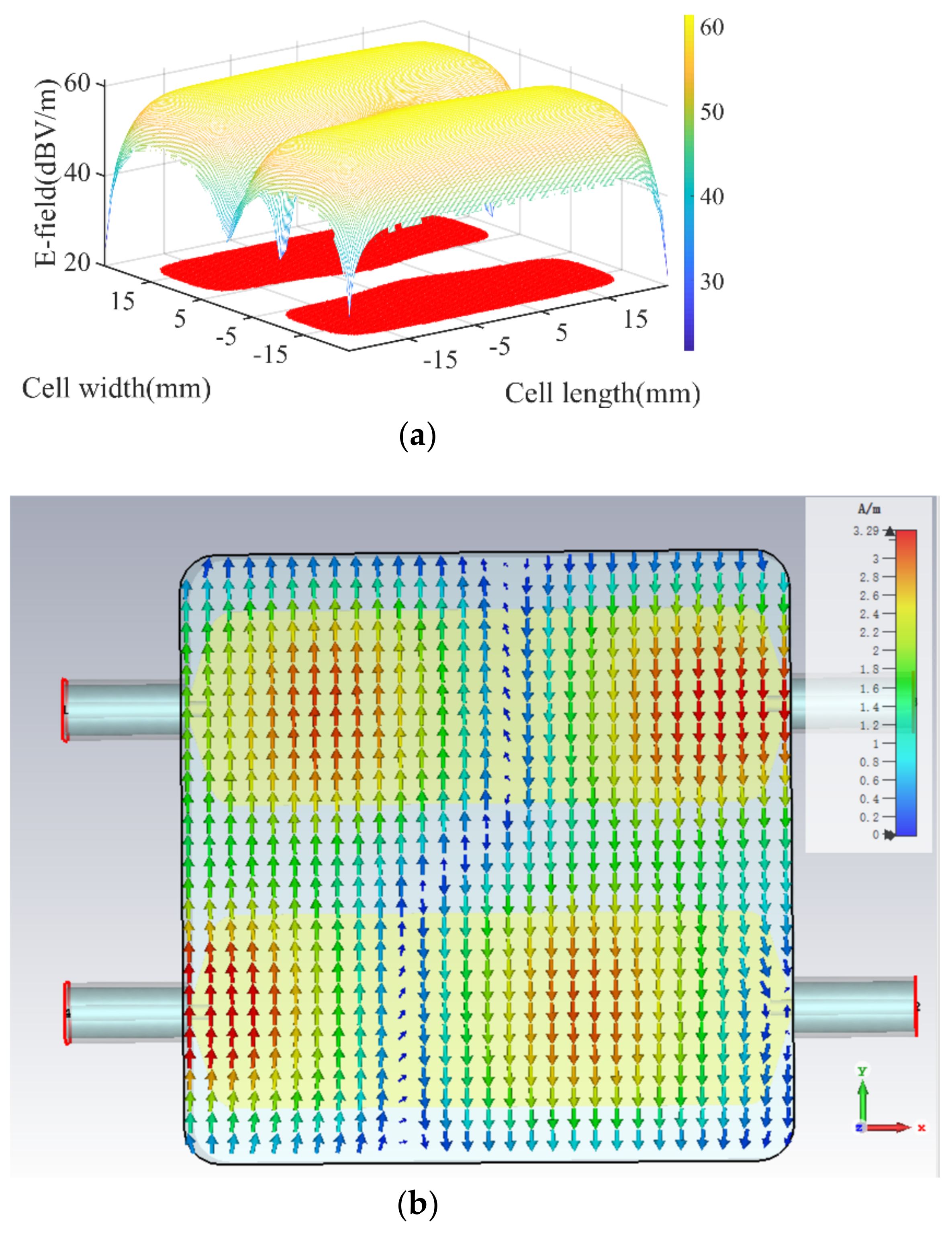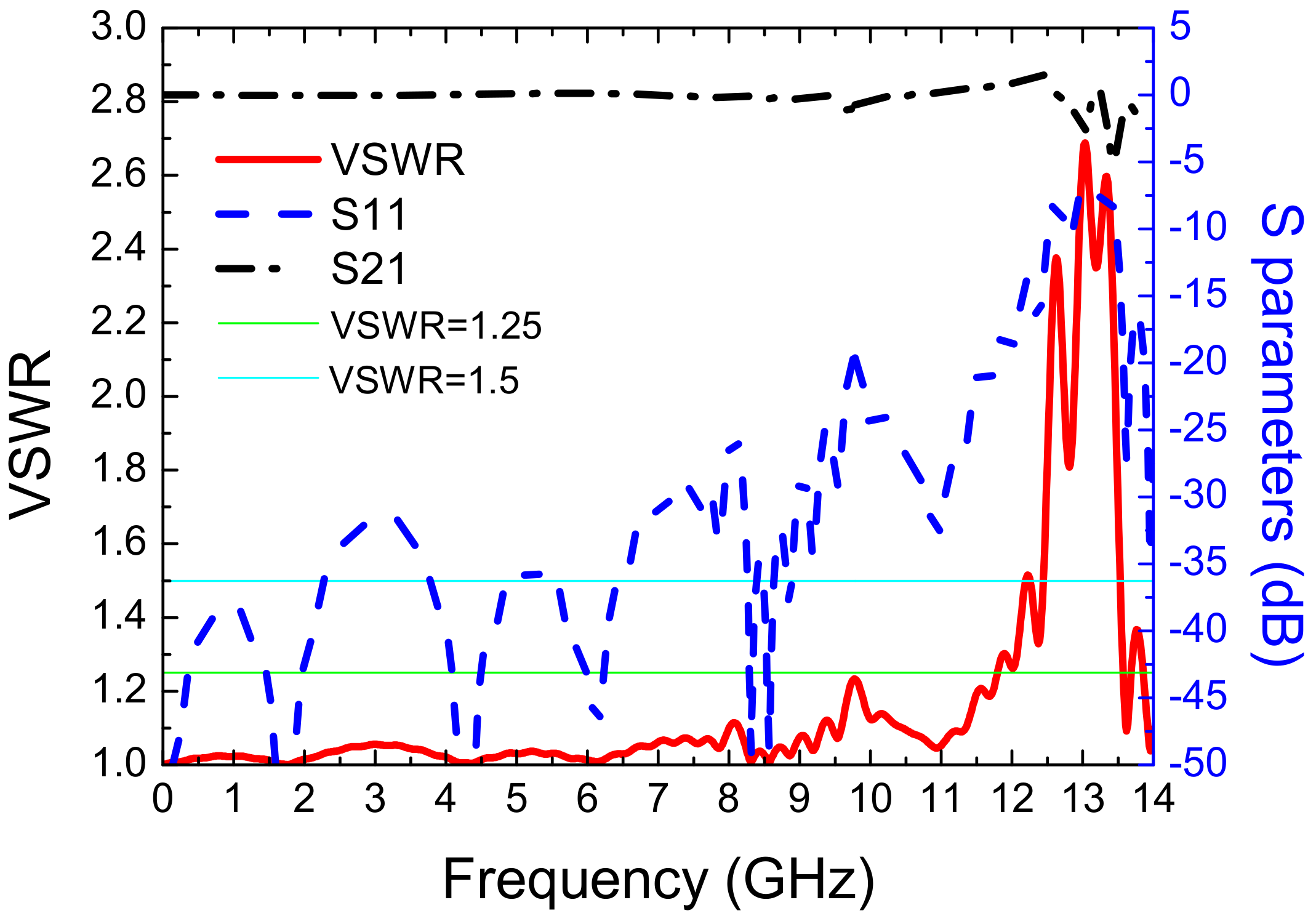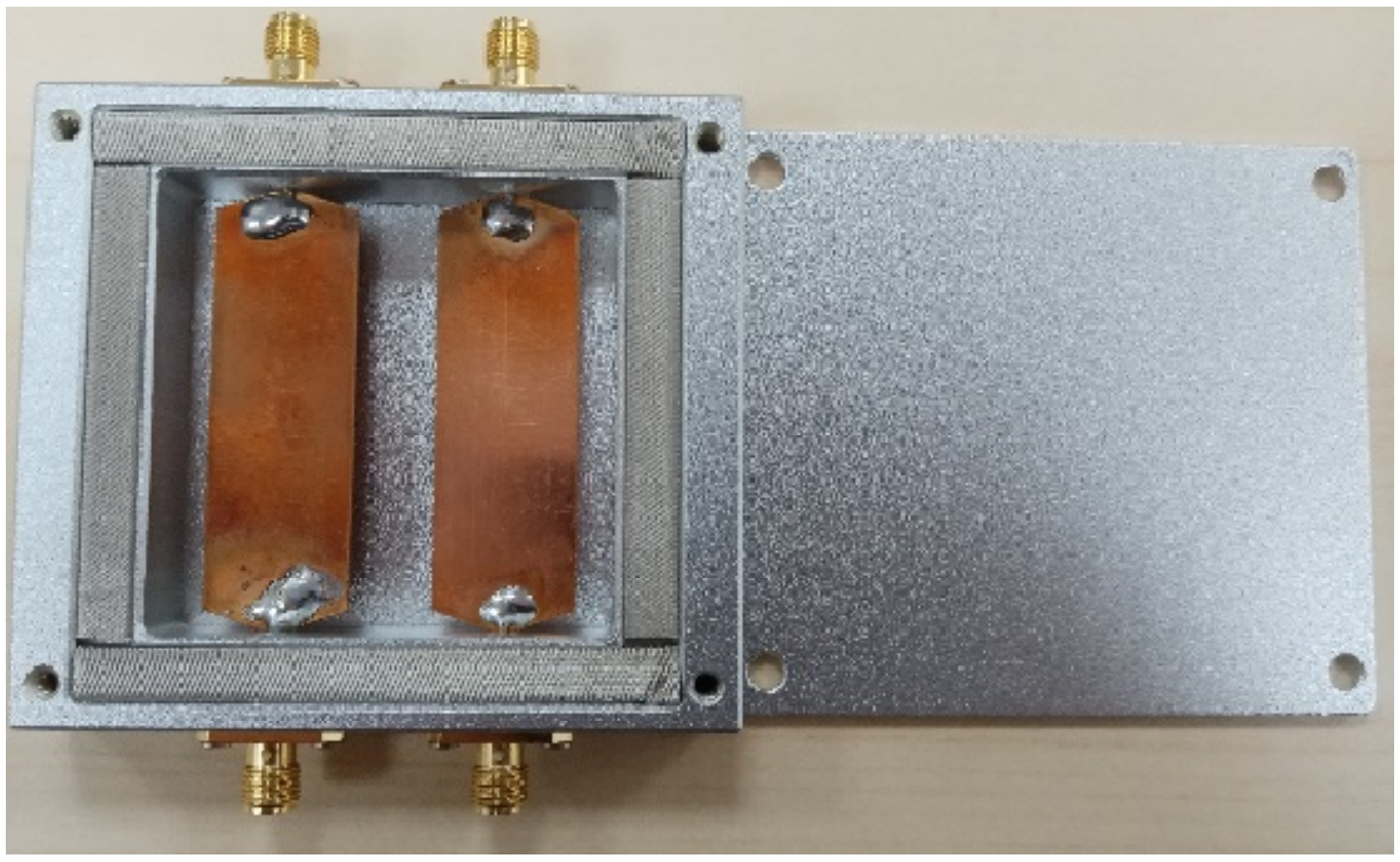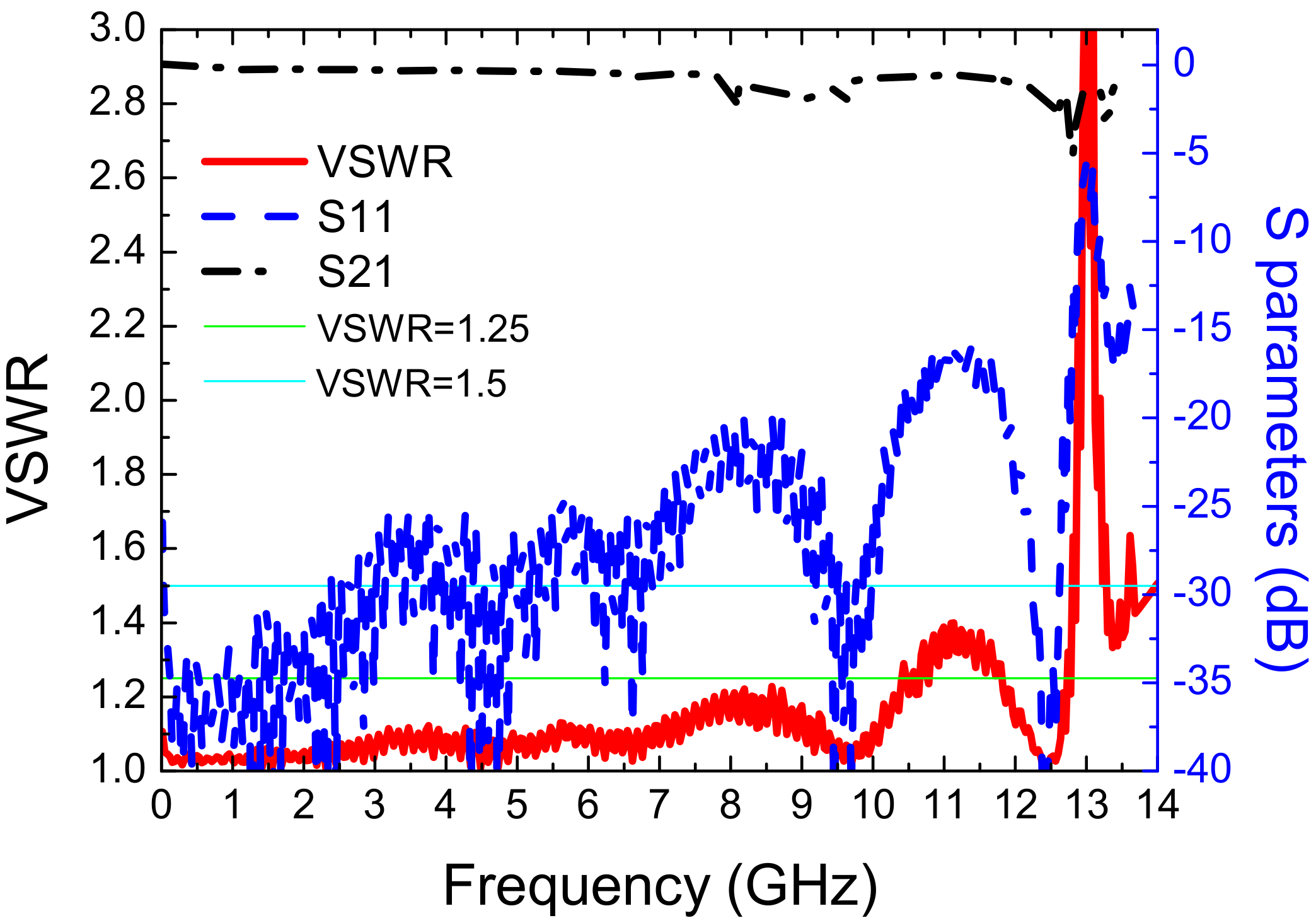1. Introduction
The rapid development of semiconductor technology makes the problem of electromagnetic compatibility (EMC) at the IC level increasingly prominent. International standards [
1] specify EMC limits at the IC level, including the radiated emission level and immunity level of the ICs. The IC-Stripline cell is the equipment used to measure radiated emission and immunity of the IC. Before using it to measure, the IC should be mounted on a printed circuit board (PCB) and inserted into the cell. When measuring immunity, the transverse electromagnetic field generated by the cell is coupled to the IC. The interference level is increased until the operation failures occur or a maximum interference level is reached. When measuring radiation emission, the electromagnetic wave radiated by the IC will be transmitted to the receiver through the cell. The receiver will record the frequency and intensity of the radiation. The shielding effect of open version IC-Stripline is poor. To ensure less interference between the measurement results and the external electromagnetic waves, a closed version of the IC-Stripline cell is often used. The closed structure makes the closed version IC-Stripline cell produce high-frequency resonance. The resonance could seriously destroy the transverse electromagnetic field, which limits its operating frequency band for measuring radiated emission and immunity of the IC. Therefore, the resonance frequency of higher-order modes is one of the effective parameters in determining the bandwidth of the cell. Expanding the bandwidth requires increasing the resonant frequency. To meet the measurement needs of high-frequency ICs, the cell is often made very small to achieve higher resonance frequency. The size of the cell will limit the size of the IC, and the small cell will not be able to measure the large size of ICs. Therefore, enlarging the size of the cell without reducing the resonant frequency is a valuable research topic.
Improvement based on the Transverse Electromagnetic (TEM) cell [
2,
3], the closed version IC-Stripline cell has a simple structure with a wider working bandwidth [
4,
5]. In the past decades, several authors have carried out substantial research on the measurement method of the TEM cell and IC-Stripline cell. In [
6], Muccioli, J.P analyzed the theoretical basis for testing the electromagnetic radiation emission of ICs with a TEM cell. In [
7,
8,
9,
10], the change of electric field in the cell was analyzed, and a small electric field change could ensure the accuracy of the EMC test. The experiments for measuring radiation emission of the IC by TEM cell or IC-Stripline cell are detailed in [
11,
12,
13]. By innovating the measurement method, the measurement accuracy of the IC is effectively improved.
In addition to the measurement methods, some authors have studied and improved the structure of the cell. In [
14,
15,
16,
17], the working principle of the traditional TEM cell is introduced and the calculation methods of parameters such as working bandwidth, characteristic impedance, and uniform field region are analyzed. In [
18,
19], the design and modeling of the open version IC-Stripline were analyzed. Although the structure of the open version IC-Stripline is simple, it will interfere with the surrounding equipment and fail to effectively shield the external electromagnetic interference.
The aim for most authors to improve the cell structure is to optimize parameters or expand the measurement bandwidth, but there is little research on the maximum IC size that the cell can measure. For example, when the IC surface area is too large to be measured by the IC-Stripline cell, the size of each part of the cell can only be expanded in equal proportion to meet the needs of the IC. However, the larger the size, the narrower the working bandwidth of the cell, which may not meet the measurement needs of high-frequency ICs.
In this paper, image theory is applied to the IC-Stripline cell, which can expand the volume of the cell to adapt to the IC with a larger surface area without reducing the measurement bandwidth.
Section 2 introduces the structure, dimensions, and measurement results of the traditional IC-Stripline cell.
Section 3 introduces the long version IC-Stripline cell.
Section 4 and
Section 5 detail the design of the IC-Stripline cell based on image theory and provides the simulation and measurement results. The conclusion is given in
Section 6.
2. Structure of the Traditional IC-Stripline Cell
The traditional IC-Stripline cell is a deformed coaxial cable, which transmits electromagnetic waves through a hexagonal septum in the middle of the cell. The shielding shell outside the cell is square, and the top wall can be opened to place the device under test (DUT). Both ends of the cell are connected to the RF cables through 50 Ω coaxial connectors. When the IC-Stripline cell works, the radiation emission and immunity of the IC are measured by the TEM field region on the top of the cell. To ensure the uniformity of the TEM field in the top area, the transmission loss and return loss of the cell must meet the requirements of standards [
4,
5].
The transmission loss (
) represents the ratio of input power to output power:
. The closer the value of
is to 0, the smaller the transmission loss inside the cell. The S21 parameter is usually used to characterize the transmission loss, and the relationship between the two is:
. Standards [
4,
5] stipulate that the transmission loss shall be less than 1 dB in 0–3 GHz.
The return loss (
) represents the ratio of input power to reflected power due to impedance mismatch:
. The greater the
, the smaller the reflected wave and the better the impedance matching of the cell.
S11 parameter and VSWR are usually used to characterize return loss. The relationship between the three is:
. Standards [
4,
5] stipulate that the VSWR shall be less than 1.25 in 0–3 GHz.
The size of the IC-Stripline cell is not fixed, and different sizes will correspond to different electromagnetic characteristics.
Figure 1 shows the three views and a picture of it.
Table 1 shows the cell parameters of three different sizes.
Figure 2 is the simulation results of VSWR and S-parameters of three cells.
The dimensions of the commonly used traditional IC-Stripline cell is “Size 2” in
Table 1 which are obtained from EM601-6 produced by ESD-EMC [
20].
Figure 1b is the picture of it. To obtain the actual electromagnetic parameters of the cell, the vector network analyzer (VNA) is used to measure S parameters and VSWR. The connection to the measurement equipment is realized using N-connectors having the 50-Ω characteristic impedance. These N-connectors have an extended central coaxial conduction insulated with Teflon, which protrudes through the cell cavity wall and connects the septum. S parameters and VSWR measurement results are shown in
Figure 3. The VSWR is less than 1.25 in 0–4.5 GHz, 1.5 in 4.5–6 GHz, and S21 is greater than −1 dB in 0–3 GHz, −1.5 dB in 3–6 GHz, both of which meet the standard [
4,
5] requirements in 0–3 GHz and the cell can be used for measurement in the range of 0–6 GHz.
When the cell works, the electric field intensity at the top area gradually weakens from the geometrical center to the periphery. The standard [
4,
5] stipulates that the area where the fluctuation amplitude of electric field intensity is less than
can be used to measure the radiation emission and immunity of the IC. The electromagnetic simulation software CST Studio 2019 is used to simulate the electric field distribution between the septum and the cover plate of the traditional closed version IC-Stripline cell. Before the simulation, the model is established. The outside conductor is made of “aluminum” and the septum is made of “copper”; the two ends of the cell are
-coaxial connectors. The background of the model is set as “normal” with its permittivity 1 and permeability 1. The boundary is set as “open”, with the estimated reflection level of almost 0. The “Frequency Domain Solver” is used to solve the problem.
Figure 4 is the model of it and the electric field distribution simulation results are shown in
Figure 5a in which the red shaded area is the projection of the area where the fluctuation of electric field intensity at the top area of the cell is less than 3 dB on the horizontal plane.
Figure 5b shows’ the magnetic field distribution simulation results.
As seen in
Figure 5a, the size of 3 dB uniform field region of the cell is about
, which means that it can be used to measure ICs with the surface area less than
. In
Figure 5b, the magnetic field distribution at the top area of the cell is parallel to the septum, and the change of the magnetic field intensity is less than 1.67 A/m, which does not affect the distribution of the uniform field. For ICs with a larger surface area, the cell is not suitable. For example, the DIP (Dual In-line Package) chips with more than 24 pins (which has a length longer than 3 cm) and the 4G communication module ML302 (the size of which is
) cannot be measured with the cell. At present, the method to measure these ICs with large surface area is to use an IC-Stripline cell with equal proportion expansion. However, its resonant frequency is low, which is not suitable for the measurement of ICs with high working frequency. Therefore, it is necessary to create new cells that can expand the area of the uniform field region but do not reduce the resonant frequency based on the cell.
3. Structure of the Long Version IC-Stripline Cell
The resonant frequency of the first higher-order mode
is determined from the cross-section of the IC-Stripline cell. The dominant mode for a rectangular IC-Stripline cell is either the
mode or the
mode. For a 50 Ω IC-Stripline cell, the cutoff frequency is calculated from (1).
where
is the speed of light in vacuum [
3].
If the aspect ratio of the IC-Stripline cell
is less than 1.92, the dominant mode is the
mode. If the aspect ratio is greater than 1.92, the dominant mode is the
mode [
3].
According to (1), the cutoff frequency of the IC-Stripline cell depends on and , independent of the longitudinal length . Elongating the IC-Stripline cells longitudinally does not affect the cutoff frequency. Since most of the ICs are square, the value of of the traditional IC-Stripline cell is the same as that of . However, theoretically, the value of can be to infinity. If extending can increase the uniform field region, the IC-Stripline cell can measure larger ICs.
Based on the theoretical analysis above, it is considered to extend
appropriately to meet the measurement of DIP chips with more than 24 pins. The maximum pins number of DIP chips is 64 (for example, Motorola 68000 and Zilog Z180), the length of which is approximately 8 cm. After multiple simulations of different lengths, the uniform field region can meet the measurement requirements when
is extended twice. The model established in CST and simulation results of the elongated IC-Stripline cell is shown in
Figure 6.
The simulation results mean that the working bandwidth of the IC-Stripline cell after longitudinal elongating is still 6 GHz.
Figure 6 shows the simulation results of the field distribution of the cell.
As seen in
Figure 7a, the area of the 3 dB uniform field region of the long version IC-Stripline cell is approximately 3 × 8 cm, which could meet the measurement needs of all DIP chips. Compared with
Figure 5b, the magnetic field in
Figure 7b exhibits a plurality of periods along the propagation direction. The period width depends on the frequency of the electromagnetic wave. The magnetic field distribution at the top of the cell is parallel to the septum, and the change in the magnetic field intensity is less than 1.65 A/m, which does not affect the distribution of the uniform field.
The manufactured long version IC-Stripline cell is shown in
Figure 8. The VNA is used to measure S parameters and VSWR. Before measuring, put the cover on the cell and connect the two ports of the cell directly to port 1 and port 2 of the VNA. The measurement results of S-parameters and VSWR are shown in
Figure 9. The VSWR is less than 1.25 at 0–5 GHz, less than 1.5 at 5–6 GHz, and S21 is greater than −1.5 dB at 0–6 GHz, both of which meet the standards [
4,
5] requirement in 0–3 GHz and the cell can be used for measurement in the range of 0–6 GHz.
The long version IC-Stripline cell has solved the problems of radiation emission and immunity measurement of ultra-long ICs in two directions, but this is only limited to measuring long strip ICs, that is, the width of ICs cannot exceed 3 cm and could not rotate the IC in 90°. To measure ICs with length and width exceeding 3 cm and rotate the IC at 90°, it is necessary to further expand the uniform field region of the cell laterally without reducing the resonant frequency.
5. Scaled-Down IC-Stripline Cell Based on Image Theory
The working bandwidth of the IC-Stripline cell is determined by the resonant frequency. The smaller the inner space of the cell, the higher the resonant frequency and the wider the working bandwidth. Therefore, it is considered to scale down the IC-Stripline cell based on image theory to have a wider working bandwidth.
The dimensions of the cell shown in
Table 2 are reduced in equal proportion. The dimensions of the scaled-down IC-Stripline cell based on image theory are shown in
Table 3. The simulation results of the field distribution are shown in
Figure 16. The 3 dB uniform field region is divided into two areas of 1.5 × 4 cm. The maximum magnetic field intensity in
Figure 16b is increased to 3.5 A/m as compared with
Figure 13b. This is because the distance between the septum and the outer conductor is closer after the cell size is reduced. In the case of the same input power, the magnetic field strength of the scaled-down cell is stronger. The total area of the uniform field region is equivalent to that of the traditional IC-Stripline cell.
Figure 17 shows the S-parameters and VSWR simulation results of the scaled-down IC-Stripline cell based on image theory. It can be seen that the VSWR of the scaled-down IC-Stripline cell is less than 1.25 at 0–9.5 GHz, and less than 1.5 at 9.5–12 GHz, that is, the working bandwidth is expanded to 12 GHz.
Figure 18 shows the manufactured scaled-down IC-Stripline cell based on image theory. The S parameters and VSWR measurement results are shown in
Figure 19. It can be seen that the S parameters and VSWR meet the requirements of standards [
4,
5] in 0–3 GHz and the cell can be used for measurement in the range of 0–12 GHz.
6. Conclusions
The long version IC-Stripline cell expands the 3 dB uniform field region of the traditional IC-Stripline cell from
to
, with the measurement frequency band remaining 0–6 GHz. The IC-Stripline cell based on image theory further expands the 3 dB uniform field region into
with the measurement frequency band unchanged. Furthermore, the scaled-down IC-Stripline cell based on image theory can expand the measurement frequency band to 0–12 GHz with
of 3 dB uniform field region.
Table 4 shows the comparison of the performance of different cells.
Although the IC-Stripline cell based on image theory effectively expands the uniform field region, the region is divided into two parts by the virtual electric wall. The traditional method for measuring the radiation emission and immunity of ICs is no longer suitable for the new cell. In future work, we will modify the measurement method to adapt to this feature.
